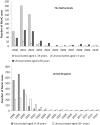Routinely vaccinating adolescents against meningococcus: targeting transmission & disease
- PMID: 26651380
- PMCID: PMC4841019
- DOI: 10.1586/14760584.2016.1130628
Routinely vaccinating adolescents against meningococcus: targeting transmission & disease
Abstract
Adolescents have the highest rates of meningococcal carriage and transmission. Interrupting the adolescent habitat in order to reduce carriage and transmission within adolescents and to other age groups could help to control meningococcal disease at a population level. Compared to immunization strategies restricted to young children, a strategy focused on adolescents may have more profound and long-lasting indirect impacts, and may be more cost effective. Despite challenges in reaching this age-group, experience with other vaccines show that high vaccine coverage of adolescents is attainable.
Keywords: Neisseria meningitidis; adolescent; carriage; cost-effectiveness; epidemiology; herd protection; transmission; vaccine.
Figures


References
-
- European Center for Disease Prevention and Control [[cited 2015 Aug 10;];Surveillance Report. Surveillance of invasive bacterial diseases in Europe 2012. http://ecdc.europa.eu/en/publications/Publications/Surveillance%20of%20I... Available from.
-
- Cohn AC, MacNeil JR, Clark TA. Prevention and control of meningococcal disease: recommendations of the Advisory Committee on Immunization Practices (ACIP) MMWR. 2013;62:1–28. - PubMed
-
- Vyse A, Anonychuk A, Jäkel A. The burden and impact of severe and long-term sequelae of meningococcal disease. Expert Rev Anti Infect Ther. 2013;11:597–604. - PubMed
-
- Jolley KA, Brehony C, Maiden MCJ. Molecular typing of meningococci: recommendations for target choice and nomenclature. FEMS Microbiol Rev. 2007;31:89–96. - PubMed
Publication types
MeSH terms
Substances
LinkOut - more resources
Full Text Sources
Other Literature Sources
